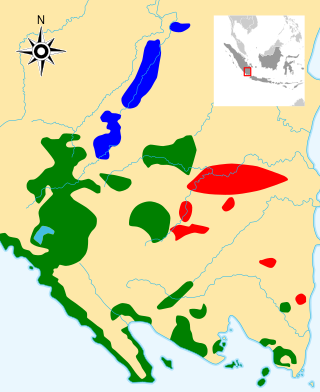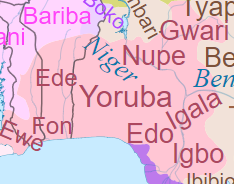Related Research Articles

Minangkabau is an Austronesian language spoken by the Minangkabau of West Sumatra, the western part of Riau, South Aceh Regency, the northern part of Bengkulu and Jambi, also in several cities throughout Indonesia by migrated Minangkabau. The language is also a lingua franca along the western coastal region of the province of North Sumatra, and is even used in parts of Aceh, where the language is called Aneuk Jamee.

Numic is the northernmost branch of the Uto-Aztecan language family. It includes seven languages spoken by Native American peoples traditionally living in the Great Basin, Colorado River basin, Snake River basin, and southern Great Plains. The word Numic comes from the cognate word in all Numic languages for “person”, which reconstructs to Proto-Numic as. For example, in the three Central Numic languages and the two Western Numic languages it is. In Kawaiisu it is and in Colorado River, and.

Valley Yokuts is a dialect cluster of the Yokutsan language family of California.

Saanich is the language of the First Nations Saanich people in the Pacific Northwest region of northwestern North America. Saanich is a Coast Salishan language in the Northern Straits dialect continuum, the varieties of which are closely related to the Klallam language.
Jambi Malay is a Malayic language spoken in Jambi province, Indonesia. It is closely related to Palembang Malay in neighbouring South Sumatra, Riau Malay in Riau Province and the surrounding islands, and Bengkulu Malay in Bengkulu Province.

The Malayic languages are a branch of the Malayo-Polynesian subgroup of the Austronesian language family. The most prominent member is Malay, which is the national language of Brunei, Singapore and Malaysia, and is the basis for Indonesian, the national language of Indonesia. The Malayic branch also includes the local languages spoken by ethnic Malays, further several languages spoken by various other ethnic groups of Sumatra, Indonesia and Borneo. The most probable candidate for the urheimat of the Malayic languages is western Borneo.

Toba Batak is an Austronesian language spoken in North Sumatra province in Indonesia. It is part of a group of languages called Batak. There are approximately 1,610,000 Toba Batak speakers, living to the east, west and south of Lake Toba. Historically it was written using the Batak script, but the Latin script is now used for most writing.

Lampung or Lampungic is an Austronesian language or dialect cluster with around 1.5 million native speakers, who primarily belong to the Lampung ethnic group of southern Sumatra, Indonesia. It is divided into two or three varieties: Lampung Api, Lampung Nyo, and Komering. The latter is sometimes included in Lampung Api, sometimes treated as an entirely separate language. Komering people see themselves as ethnically separate from, but related to, Lampung people.

The Volta–Niger family of languages, also known as West Benue–Congo or East Kwa, is one of the branches of the Niger–Congo language family, with perhaps 70 million speakers. Among these are the most important languages of southern Nigeria, Benin, Togo, and southeast Ghana: Yoruba, Igbo, Bini, and Gbe.
Hashimoto Mantarō was a Japanese sinologist and linguist who is best known for advocating research on language geography, linguistic typology, and how different areal features in the varieties of Chinese reflect contact with other language families.
William Hubbard Baxter III is an American linguist specializing in the history of the Chinese language and best known for his work on the reconstruction on Old Chinese.
North Junín Quechua is a language dialect of Quechua spoken throughout the Andean highlands of the Northern Junín and Tarma Provinces of Perú. Dialects under North Junín Quechua include Tarma Quechua spoken in Tarma Province and the subdialect San Pedros de Cajas Quechua. North Junín Quechua belongs to the Yaru Quechua dialect cluster under the Quechua I dialects. Initially spoken by Huancas and neighboring native people, Quechua's Junín dialect was absorbed by the Inca Empire in 1460 but relatively unaffected by the Southern Cuzco dialect. The Inca Empire had to defeat stiff resistance by the Huanca people.

Helong is a Central Malayo-Polynesian language of West Timor. Speakers are interspersed with those of Amarasi. This language has become endangered as a result of its native speakers marrying those who do not speak Helong, and as a result of coming in contact with the outside community. Helong speakers are found in four villages on the South-Western coast of West Timor, as well as on Semau Island, a small island just off the coast of West Timor. The mostly Christian, slightly patriarchal society of Semau do their best to send their children away to Bali to earn money to send home.

Gabriella Hermon is an American linguist, professor emerita at the University of Delaware.
Gumuz is a dialect cluster spoken along the border of Ethiopia and Sudan. It has been tentatively classified within the Nilo-Saharan family. Most Ethiopian speakers live in Kamashi Zone and Metekel Zone of the Benishangul-Gumuz Region, although a group of 1,000 reportedly live outside the town of Welkite. The Sudanese speakers live in the area east of Er Roseires, around Famaka and Fazoglo on the Blue Nile, extending north along the border. Dimmendaal et al. (2019) suspect that the poorly attested varieties spoken along the river constitute a distinct language, Kadallu.
Wei-Heng Chen is a Chinese linguist who is a professor of English and linguistics at Beijing Language and Culture University. Chen was the education consul of China at the Chinese Consulate-General, Los Angeles.
There are several differences in pronunciation between Standard Arabic and Tunisian Arabic. Nunation does not exist in Tunisian Arabic, and short vowels are frequently omitted, especially if they would occur as the final element of an open syllable, which was probably encouraged by the Berber substratum.
The Sogeram languages are a family of languages in the Madang stock of New Guinea. They are named after the Sogeram River.
The Moklenic or Moken–Moklen languages consist of a pair of two closely related but distinct languages, namely Moken and Moklen. Larish (1999) establishes the two languages as forming two distinct subgroups of a larger Moken–Moklen branch. Larish (2005) suggests Moklenic as an alternative name for Moken–Moklen, the latter term which was originally used by Larish (1999).
Peter Cole (1941–2023) was an American linguist who made notable contributions to comparative grammar, in particular to the study of Hebrew, Quechua, Chinese and Malay syntax.
References
- ↑ Kerinci at Ethnologue (18th ed., 2015) (subscription required)